With tire technologies improving, manufacturers are able to design and produce various tire models for various applications. From touring and performance tires to aggressive off-road models, vehicle owners need to decide which tires would work for them the best.
Do you know the difference between versatile car tire types and which one would work for you?
Let us walk you through the basics of passenger car, SUV, and light truck tires!
Table of Contents:
Why Are There Different Types of Tires in the Market?
There is a good reason for this!
Different types of tires are manufactured by tire brands as these versatile tires are for various applications. The tread patterns, compound blends, internal structures, and sizes are used for different purposes.
Furthermore, apart from the general all season, summer, and winter tire debate, we also need to look at distinctive road surface conditions. All of these applications require special tread designs and compounds to ensure the vehicles' secure and precise performance. Traction has to be provided as well, which requires contrasting patterns on diverse surfaces and conditions.
For example, performance tires need consistent road contact to create traction, while off-road models feature large tread blocks for the same reason.
Tire Types - Fast Facts:
- All Season Tire: is a hybrid between winter and summer tires, which provides good traction in dry, wet, and winter weather
- Summer Tire: use their heat-resistant compound and minimalistic tread area to provide dry and wet weather traction
- Winter Tire: features detailed footprints to conquer ice- and snow-covered, cold temperature weather conditions
- Off-road Tire: sport larger blocks and a high void ratio to ensure traction on versatile terrains while keeping a clean footprint
Different Car Tires by Season
When talking about car tires, the weather can greatly alter the tire type vehicles need. Generally speaking, there are three main seasonal types of tires available for purchase, with the forth type slowing conquering the tire market.
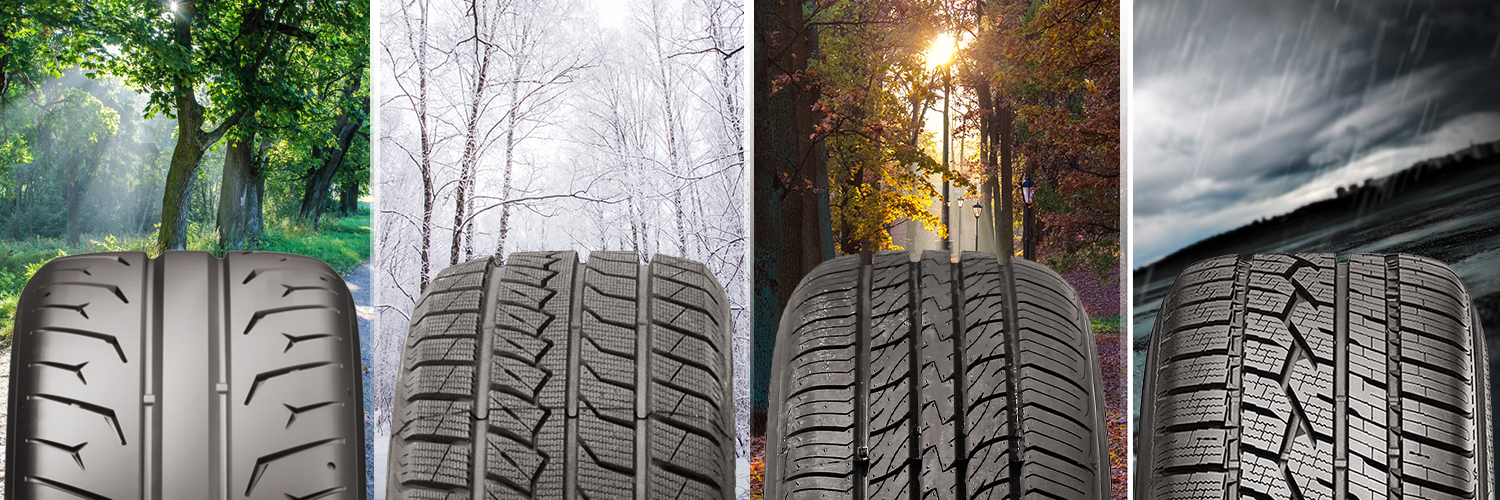
Summer Tires
Summer tires are manufactured for high-heat weather conditions. These feature minimalistic tire treads, which are often ribbed or asymmetric. The footprint is molded from heat-resistant compounds that ensure its secure performance. Summer tires are for above 45°F temperatures.
These tires need to provide traction in dry and wet weather situations. Stronger compounds keep the tire cool, even in warmer temperatures or during its high speed applications. On the other hand, the tread of summer tires guarantees consistent surface contact to provide traction.
Winter Tires
Winter tires feature the most detailed tread patterns, which are designed from stronger winter compounds. Their combination ensures the tire's freezing temperature, and ice and snow traction. Winter tires sport the three-peak mountain and snowflake symbol (3PMS) which indicates their severe winter weather applications.
The footprint's characteristics have detailed siping placement, which is used to generate biting edges and create traction. The ideal winter compound does not allow the tire to freeze in cold temperatures, enabling its performance even below 45°F.
All Season Tires
The combination of the previous two categories is all season tires. These tires can handle both warm and cold temperatures, thanks to their flexible compound blends and optimized footprint. They provide traction in dry, wet, and light winter conditions, but they are not for harsh terrain performance.
Apart from the all season compound, these tires sport wide circumferential grooves. These grooves not only offer traction, but also combat hydroplaning in wet conditions. This minimizes the possibility of one of the most common road hazards.
All Weather Tires
All weather or five season models are considered to be true year-round tires. "What is a five season tire?" you might ask.
They are basically more durable all season tires, which also feature the 3PMS symbol. This means that they provide excellent summer and winter performance, by utilizing their optimized tread design and flexible compound blends!
Different Tires Based on Performance
Passenger car, SUV, and light truck tires which are strictly for on-road use fall into one of the below three categories. These models offer versatile performing characteristics, each of which is for specific applications. Let's see what they are!
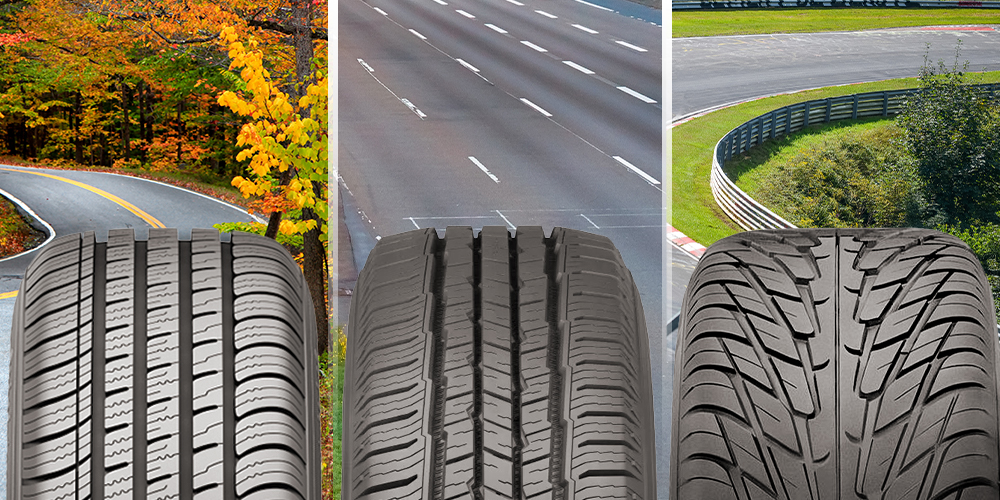
Touring Tires
A touring tire guarantees driving comfort! The primary focus of these models is reduced road noise and vibration levels while providing moderate handling. This is achieved with versatile technologies tire manufacturers use during production.
Most of these tires belong to the all season touring tire category. However, some winter tires can also be considered touring. Additionally, due to their flexible compound and stable road contact, these tires also offer lengthened usability.
Highway Tires
Highway tires are more durable! They are manufactured for SUVs and light trucks, as their primary goal is offering the necessary load and driving durability throughout their performance. They are meant to be used strictly on-road, but some models can offer slight off-road traction as well.
What's great about highway tires is their durability. Not only do they provide a secure performance for SUVs and light trucks, but they guarantee a longer-lasting tread life. They often provide high driving comfort levels as well. They are mostly radial tires, but bias-ply models are also manufactured.
Performance Tires
High speed vehicles need performance or UHP tires. These tires focus on providing sharp handling, even at high speeds. They use their stable footprint, stronger structure, and heat-resistance in order to safely perform at their best capability.
Wet weather traction is guaranteed with their wide groove placement, while durable compounds enable the tire to increase surface traction. Since they are performance-oriented models, performance tires do not come with the best tread life.
Tires for Different Types of Terrains
Off-road tires can also be categorized. Different off-road tire types offer various levels of terrain and on-road traction, enabling their secure performance. While all of these tires can be used off-road, the terrains they are able to conquer differ.
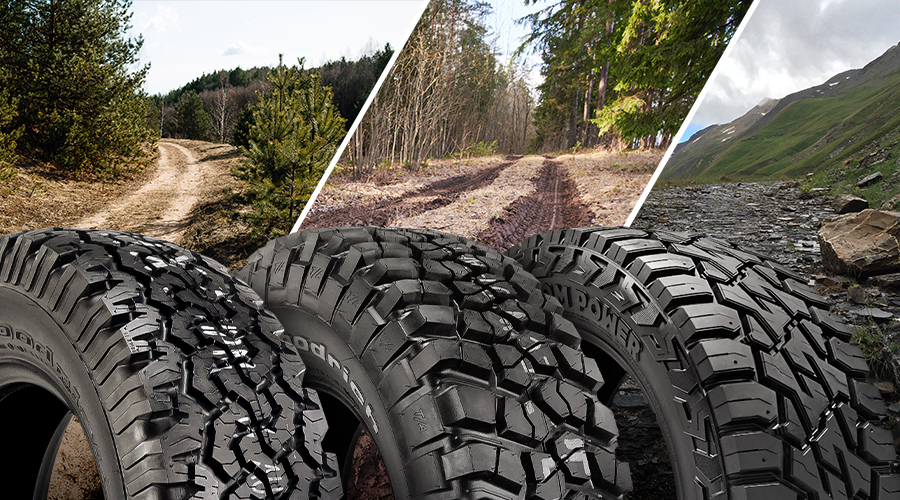
All Terrain Tires
All terrain tires are designed with more aggressive tread designs compared to highway and touring tires. They use their tread blocks to provide off-road traction, while also minimizing discomfort during their on-road drive.
AT tire models keep their footprint clean, greatly optimizing their terrain traction. These tires are designed for both on- and off-road performance and most of them offer good comfort levels throughout the drive.
Mud Terrain Tires
Mud terrain tires are the true royalty of off-road driving. Their aggressive footprints sport large tread blocks and high void ratios, which provide off-road traction and keep the footprint clean. Their primary focus is versatile terrain traction, not on-road driving comfort.
Additionally, MT tires feature reinforced sidewalls and durable constructions that protect the tire from external damage. They offer a rugged aesthetic look for the vehicles they are mounted on.
Rugged Terrain Tires
Rugged terrain tires are the newest trend in the tire market. They are a hybrid category between AT and MT tires. These tires guarantee exceptional off-road traction (much like MT models), without ruining on-road comfort levels (like AT tires).
Their sport-aggressive footprints not only guarantee superb soft, loose, and uneven terrain traction, but also offer great on-road comfort levels. Furthermore, load durability, damage resistance, and controllability are also guaranteed.
Types of Spare Tires
Let's speed run through versatile spare tire types!
Generally speaking, we can talk about full-sized and temporary spare tires. These different models have their own pros and cons.
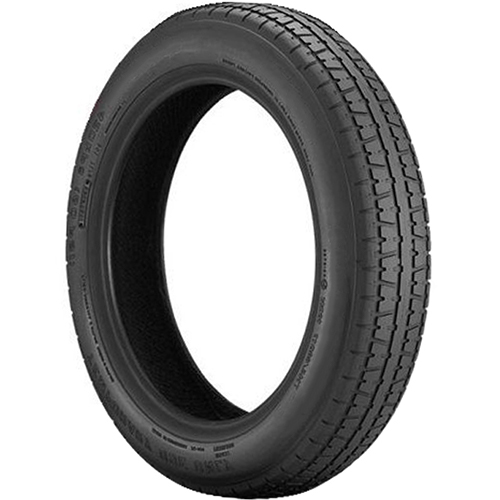
Full-sized spare tire: They are the same size as the rest of the tires, offering the same performance and traction, but they take up a lot of trunk space.
Temporary spare tire: They are manufactured in smaller physical sizes, offering limited performance and speed durability, but need less trunk space for storage.
Run Flat Tires
Run flat tires have been around for a while. They provide limited, temporary performance after air pressure loss thanks to various run flat technologies. These tires can be driven for 50 miles, up to 50 mph.
Most major tire manufacturers have their own run flat technology. They offer an excellent alternative to spare tires, as they make sure the vehicles are not stranded on the side of the road.
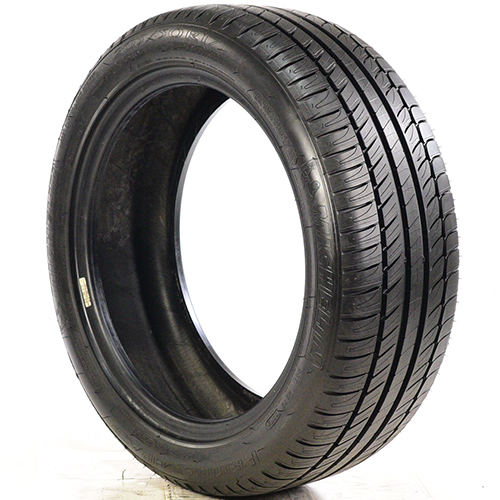
The best part? Run flat tire technology is so widespread nowadays that they are available in versatile tire categories. They are available for all weather conditions, and in different on-road applications, allowing vehicle owners to choose the best ones for their vehicles!
Touring Tires vs All Season
How are touring and all season tires different from each other?
Most all season tires offer moderate comfort levels, handling, and performance. Their trump card is the dry, wet, and light winter weather traction that is promoted.
Compared to them, touring tires offer excellent driving comfort and sharper handling. They are often used for commuting, as they ensure their safer driving experience.
All Terrain vs All Season Tires
Most all terrain tires are also all season models. However, vice versa is not true!
All terrain, or AT, tires offer excellent traction on versatile on- and off-road terrains. The traction they offer focuses on the different driving surfaces they offer. On the other hand, all season tire models aim to promote dry, wet, and winter conditions, disregarding driving surfaces.
All season tires will provide traction throughout the year, but the performance of specific tires might not offer good off-road drives. All terrain tire models ensure a safe drive in versatile temperatures, often even offering severe winter weather grip.
So, which one do you need?
Odds are that if you need an all terrain tire set, they will be all season. However, if you do not drive off-road, a touring or performance, all season set would be a better choice.
Frequently Asked Questions
Do Winter Tires Make a Difference?
Yes, winter tires make a difference in severe winter conditions. Their detailed tread pattern and durable winter compounds work together to enable their ice and snow traction, even in freezing temperatures. Winter tires are made for areas where severe winter conditions rule.
What Is a Performance Tire?
Performance tires are designed and produced for high speed durability. They are often used on sports cars and other vehicles where sharp and precise handling at higher speeds is required. These tires are manufactured with higher speed ratings to ensure their driving safety.
What Are Touring Tires?
Touring tires are manufactured for passenger vehicles and SUVs. Their main characteristic is the comfort and traction these tires offer. Versatile technologies are offered with the touring tires, which guarantee high driving comfort levels and optimized all season traction.
How Much Are New Tires For a Car?
Generally speaking, new tires for a passenger vehicle can cost about $50-$150 for budget-friendly models. However, some high performance tires and top-tier brands are more expensive. Moderate tire prices range from $150 to $300, while high-end tires are above $300.




Login and Registration Form